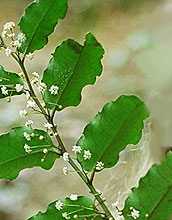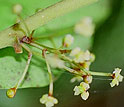News Release 06-084
Ancient Plant Provides Clues to Evolutionary Mystery
Novel reproductive structure in a South Pacific plant may be missing link between flowering plants and their ancestors

Amborella trichopoda first appeared on Earth 130-million years ago.
May 17, 2006
This material is available primarily for archival purposes. Telephone numbers or other contact information may be out of date; please see current contact information at media contacts.
The plant species, Amborella trichopoda, which first appeared on Earth 130 million years ago, has a unique reproductive structure--evidence this so-called "living fossil" may represent a crucial link between modern flowering plants and their predecessors.
William Friedman, an evolutionary biologist at the University of Colorado at Boulder, used a combination of laser, fluorescence and electron microscope images to discern that a structure that houses the Amborella egg is different from any other flowering plant and is reminiscent of more ancient plant lineages. Friedman's study appears in the May 18 issue of Nature.
Land plants first appeared on Earth some 450 million years ago. These early plants flourished for about 300 million years and reproduced in many ways, including through the use of cones--like today's conifers--but they did not produce flowers. Flowering plants first appeared about 130 million years ago and quickly came to share and then dominate the landscape.
Today, scientists have catalogued about 300,000 species of flowering plants living on Earth. Understanding their rapid appearance and rise to dominance has perplexed scientists ever since Charles Darwin first referred to it as an "abominable mystery" 130 years ago.
Friedman has worked for years to solve the mystery by studying the reproductive structures and processes of living and extinct plants. Results show the reproductive structures of Amborella are true flowers, have a unique embryo sac, and provide an anatomical bridge between the structures seen for cone-bearing and flower-bearing plants. The species is found in rain forests of New Caledonia, east of Australia.
William Winner, the National Science Foundation program manager who oversees Friedman's research said, "By studying this ancient plant species in the context of its relatives--both living and extinct--Friedman is clarifying the basic elements of evolutionary theory. This study has provided another clue to solve Darwin's mystery."
For more information on this work, see the University of Colorado at Boulder press release.
-NSF-
-
Scientists study Amborella to learn more about evolutionary processes.
Credit and Larger Version
Media Contacts
Richard (Randy) Vines, NSF, (703) 292-7963, email: rvines@nsf.gov
Jim Scott, University of Colorado at Boulder, (303) 492-3114, email: Jim.Scott@colorado.edu
Program Contacts
William E. Winner, NSF, (703) 292-8421, email: wwinner@nsf.gov
Principal Investigators
William Friedman, University of Colorado at Boulder, (303) 492-3082, email: ned@colorado.edu
The U.S. National Science Foundation propels the nation forward by advancing fundamental research in all fields of science and engineering. NSF supports research and people by providing facilities, instruments and funding to support their ingenuity and sustain the U.S. as a global leader in research and innovation. With a fiscal year 2023 budget of $9.5 billion, NSF funds reach all 50 states through grants to nearly 2,000 colleges, universities and institutions. Each year, NSF receives more than 40,000 competitive proposals and makes about 11,000 new awards. Those awards include support for cooperative research with industry, Arctic and Antarctic research and operations, and U.S. participation in international scientific efforts.
Connect with us online
NSF website: nsf.gov
NSF News: nsf.gov/news
For News Media: nsf.gov/news/newsroom
Statistics: nsf.gov/statistics/
Awards database: nsf.gov/awardsearch/
Follow us on social
Twitter: twitter.com/NSF
Facebook: facebook.com/US.NSF
Instagram: instagram.com/nsfgov

